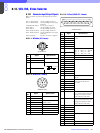
9
Chapter 9 Glossary – Terms and Definitions 174HDC-900/950/930 Series Product Information Manual
compared in numbers, it does not appear in the
specifications of the brochure. However, it is very
important for evaluating picture quality intuitively.
Usually, it is only called “DTL (detail)”.
IT/FIT
In an IT type CCD, beside the pixels there are columns
of cells dedicated for vertical transfer. The electronic
signals are transferred from the pixels to the columns
of cells during vertical blanking. Finally, the signals
reach a row of cells driven by a horizontal block for
horizontal transfer, from where the signals are output
as video signals. Although there is a cover to protect
the cells from light leakage, sometimes the leakage still
happens under a strong light, which causes smear.
To avoid this phenomenon, in an FIT type CCD,
there is additional storage added to the CCD which
enables the vertical transfer to perform much more
quickly so to minimize the chance of light leakage even
under a strong light. However, this additional storage
increases the cost.
Recently, there has been great advances in IT CCD
technology and the gap between IT and FIT has been
dramatically reduced.
Knee aperture
Contrasts always become worse when compressing in
the direction of the bright level during knee correction.
Knee aperture is used to improve this point to
emphasize the contour to which the knee correction
applies.
Knee correction
The dynamic range of a natural scene is very large, but
that of a video standard is limited. When we use the iris
to adjust for the subject photographically, the bright
portion of the picture will become almost completely
white. However, when we focus on the bright portion,
the subject for photography will become very dark.
Knee correction is a function to solve this problem by
compressing the level of the bright area to meet that in
the video standard so as to make the dynamic range
seem larger.
Knee point and knee slope
Knee point is the starting point of the knee correction
process, and the knee slope is its compression rate.
Usually, knee slope is the peak value under an
environment of 200% incident light.
Knee saturation
Because knee correction performs independently in R/
G/B channels in a conventional knee circuit, the R/G/B
percentage of the portion to which the knee correction
applys will change, and thus the color phase and
saturation change. This is called “white clip” or “wash
out.” Knee saturation is used to balance the coloring to
avoid this phenomenon.
Level depend
Just like Crisp reduces noise, level depend is a circuit
that decreases the DTL value in dark areas.
Limiter
A limiter is a circuit used to constrain the DTL peak
value that may ruin the picture quality when the
luminance difference is too big that it will generate too
large of a DTL.
Linear matrix
The linear matrix is actually a circuit used to make the
color reproduction look better, although some
textbooks mention that it is used to correct the
difference between camera chromaticity and that of
the signal standard. It seems that the linear matrix
should be more important to emphasize the visual
appeal of the picture apparently rather than just be
theoretically determined by some coefficients.
Mix DTL/NAM DTL
Recently, most of the cameras create V DTL from all
three channels of R/G/B. Depending on how to apply
these three values of V DTL to the add operation, there
are two types of mix: the Mix DTL – a simple sum of the
values and the NAM DTL – a non-additive mix of the
values. Both of them have pros and cons. The Mix DTL
is not always better than “out of green”, while the NAM
DTL helps make a picture sharper but sometimes it
makes the S/N become worse or adds the DTL
opposite to the luminance. The NAM DTL does not
apply to H DTL, because it will increase aliasing.
Multi matrix
Multi matrix is used to easily implement color
reproduction that complies with color matching and
visual appeal between different cameras by adjusting
the matrix coefficient to match the color phase. For
instance, it is possible to change the color phase and
saturation of red color only. In most of Sony’s cameras,
it works with 16 axes for color phase on a color plane
like a vector, each of which has its own matrix
coefficient to perform the linearity corrections between
each axis. Normally, each axis needs six matrix
coefficients (that means 96 matrix coefficients are
needed). However, the number of coefficients can be
reduced to two for each axis in most of Sony’s cameras
using some dedicated software - color phase and
saturation.
On-chip-lens
To obtain a better quality picture, -the more pixels the
better for a CCD. However, increasing the number of
pixels means decreasing the pixel size. When the pixel
size becomes smaller, less incident light can be
gathered, which degrades the sensitivity. The on-chip-
lens is a micro lens put on each pixel to help increase
light gathering so to improve the sensitivity.
Optical filter
There are two types of optical filters, Neutral Density
(ND) filter and Color Temperature Conversion (CC)
filter. The former is like a pair of sunglasses for the
camera to avoid the iris to be stopped down too much
under a very strong light, while the latter works like a
pair of colored glasses to compensate for the color
temperature beyond the white balance compensation
range. Both of them are integrated on a built-in filter
disk, can be manually or electronically controlled and
can be remotely controlled using the remote controller
for the electronic filter.
Optical low pass filter
Shooting with a CCD camera means sampling a
picture via the use of the pixels on a CCD. An optical
low pass filter is made of optical crystal to cut off the
unnecessary high frequency that might cause beat
interference caused by the relation between the
number of pixels and the pattern of the shooting
subject during the sampling.
Out of green
The older version cameras create V DTL from the G
channel and add it to each channel to carry out image
enhancement. This method helps use a less number of
delay lines, but does not perform well in some cases
such as a deep red flower picture. Some cameras
create V DTL from R/G channels.


















